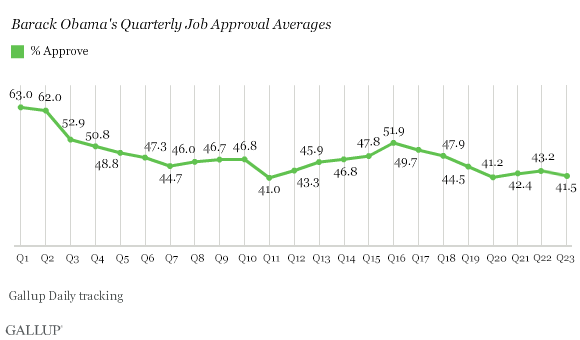Story Highlights
- Barack Obama averaged 41.5% approval during his 23rd quarter.
- Obama has had only two lower quarterly averages.
- His 23rd qtr. ranks among the lowest for post-WWII presidents
WASHINGTON, D.C. -- President Barack Obama's job approval rating averaged 41.5% during his 23rd quarter in office, which began on July 20 and ended on Oct. 19. That ranks as one of his lowest quarterly approval ratings to date. The only two that were lower were the 41.2% in his 20th quarter -- after the troubled launch of the health insurance exchanges last fall -- and the 41.0% in his 11th quarter during the negotiations to raise the federal debt limit and its fallout on the U.S. economy.

Obama's first quarter in office, when his approval rating averaged 63.0%, still ranks as his best. Since his first year, his average quarterly approval ratings have all been below 50%, with one important exception -- in the fall and early winter of 2012, the quarter in which he won re-election. Obama's job approval rating has averaged 48% throughout his nearly six full years in office.
During his 23rd quarter, Obama's Gallup Daily tracking job approval ratings fell to as low as 38% in early September, tying his personal low. That came after the Islamic militant group ISIS beheaded two American journalists. His approval rating did rise to 45% in Sept. 19-21 polling, shortly after he announced an expanded U.S. program of military airstrikes against ISIS in Iraq and Syria.
Obama 23rd Quarterly Average Among Lowest
Five post-World War II presidents have been elected to office twice and served a full 23rd quarter in office. Among these, George W. Bush has the lowest 23rd quarter average approval rating at 39.1%, just slightly lower than Obama's. In contrast, Dwight Eisenhower, Ronald Reagan and Bill Clinton were much more popular at this stage in their presidencies, with average 23rd quarter approval ratings of 56% or better.

The importance of a president's 23rd quarter average cannot be understated, as it signifies his political standing heading into the second midterm election of his presidency. Typically the president's party's fortunes in the midterms are heavily tied to his popularity.
For example, the Republicans suffered heavy losses in the 2006 midterm elections under Bush, losing majority control of both the House of Representatives and the Senate. Republicans also performed poorly in the 1974 midterms, just after what would have been Richard Nixon's 23rd quarter in office. He resigned in August just after his 23rd quarter began, with his only job approval rating measured during that quarter at 24%.
In contrast, presidents who were relatively popular in their 23rd quarters -- including Reagan and Clinton -- saw their parties perform better in the midterms. In fact, in 1998, Democrats gained seats in the House in 1998 under Clinton, a rare occurrence for the president's party in midterm elections.
Implications
Obama's job approval rating continues to languish near his personal lows, creating a strong headwind for Democratic candidates in next month's midterm elections.
Based on the historical record, it would not be surprising if Obama's approval ratings decline further over the next three months. Although there are only four twice-elected presidents who have served 24 quarters in office since Gallup began polling on presidential approval, in three out of four cases their 24th quarter average was lower than their 23rd quarter average. Clinton was the exception, as his approval rating went up, which may have been the result of a strong economy and a rally in support in reaction to Republicans' attempts to impeach him and remove him from office -- which Americans opposed. By contrast, Reagan's 24th quarter approval rating took a nosedive of 10 percentage points as the Iran-Contra scandal exploded. Bush and Eisenhower saw more modest declines.
This limited historical pattern suggest the odds are against Obama's approval ratings improving in the next quarter. And if Democrats have a poor showing on Election Day, Nov. 4 -- including possibly losing their Senate majority -- Obama will likely be politically weakened. If his job approval rating declines as a result, he may end the next quarter with his lowest quarterly average.
Survey Methods
Results for this Gallup poll are based on telephone interviews conducted July 20-Oct. 19, 2014, on the Gallup U.S. Daily survey, with a random sample of 45,640 adults, aged 18 and older, living in all 50 U.S. states and the District of Columbia.For results based on the total sample of national adults, the margin of sampling error is ±1 percentage point at the 95% confidence level.
Each sample of national adults includes a minimum quota of 50% cellphone respondents and 50% landline respondents, with additional minimum quotas by time zone within region. Landline and cellular telephone numbers are selected using random-digit-dial methods.
Learn more about how the Gallup U.S. Daily works.

